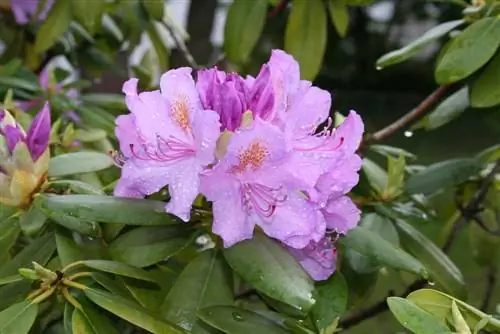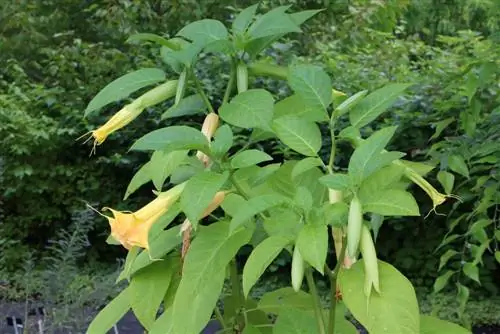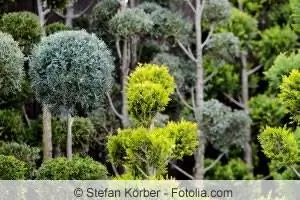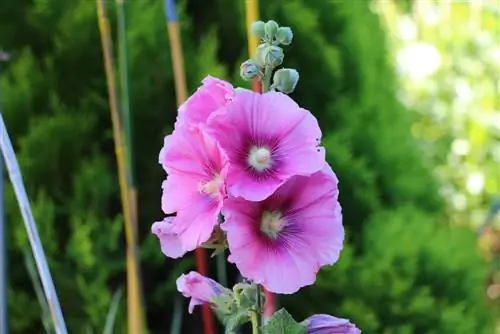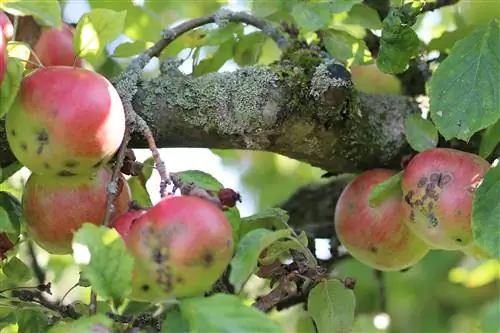- Author admin [email protected].
- Public 2023-12-17 03:39.
- Last modified 2025-01-24 12:45.
The rhododendron is a tree that can be found in many gardens. On the one hand, this is because it has beautiful inflorescences and therefore brings a lot of color to the garden. On the other hand, it is quite uncomplicated to care for, which certainly also increases its popularity. Because if the location is right and the rhododendron gets enough water, it will grow and thrive on its own.
If the location and the supply of water or nutrients are not right, then this uncomplicated tree can cause problems from time to time. Because then the rhododendron is susceptible to diseases, which are often caused by pests.
Best possible conditions for rhododendrons
Diseases and pests can only occur more frequently if the rhododendron does not feel comfortable in its environment and with its care. For this reason, you should pay attention to the following things if you want to plant a rhododendron in your garden:
- Make sure that the rhododendron is in partial shade.
- The location should be protected from wind.
- The soil should be acidic, loose, low in lime and contain humus.
- Rhododendron should be watered daily. However, waterlogging must not form.
Tip:
Since the rhododendron has quite shallow roots, deep-rooted plants should be among the shady neighbors. This means the roots don't get in each other's way and pull each other's nutrients from the soil. Pines or oaks would be suitable, among others.
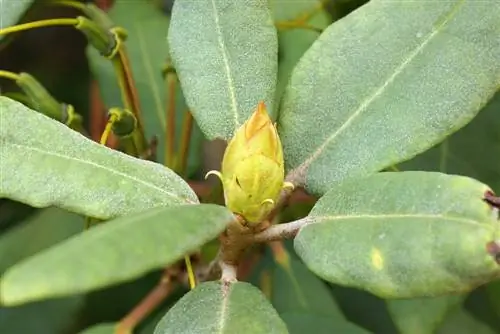
Pay attention to these things when planting and caring for it, then you will have created a good foundation for the rhododendron to thrive. Despite all this, you should always pay attention to the following clinical pictures.
Deficiencies and their effects
With rhododendrons, two deficiency symptoms can lead to serious damage to the tree. On the one hand, this is the nitrogen deficiency. If this is the case, a light green or sometimes yellow color can be seen on the older leaves of the tree. The further the nitrogen deficiency progresses, the more leaves are lost. In an advanced stage also the young leaves. In addition, the rhododendron loses its leaves early and only a few or none of the flowers sprout.
As a countermeasure, we recommend fertilizing with nitrogen, which restores the balance in the soil and thus gives the tree new strength.
In addition, an iron deficiency (iron deficiency chlorosis) can lead to damage to the rhododendron. This deficiency can be seen, among other things, in the young leaves, which are very light on the leaf surface but have very dark leaf veins. Experts call this condition chlorosis. If there is an iron deficiency, the pH value of the soil is too high. The plant cannot absorb the iron from the soil and suffers.
Remedy can be achieved by correcting the pH value. There are special iron-containing preparations available commercially for fertilization that contain many trace elements and thus optimize the soil again. The best possible pH value is between 4.5 and 6.
Specific pest: Rhododendron web bug
Pests also affect the rhododendron to a large extent. Pay particular attention to the rhododendron web bug. The small bug lays its eggs on the underside of the leaves. As a rule, this happens in the fall. They overwinter there and the bug larvae hatch in May of the next year. The rhododendron responds with mottled leaves that gradually wither. If you want to take action against this, then spray the rhododendron after flowering with Spruzid Pest Free, a product that helps against sucking insects. This remedy is biological, so there is no need to bring out the “chemical club”.
Furrowed Black Weevil
The furrowed weevil also shows great interest in rhododendrons. It eats the leaves - preferably from May onwards. The nibbling on the leaves isn't that bad. The larvae of the small beetle are much worse. They go to the roots of the rhododendron and can ensure that it dies. Therefore, take preventive measures in good time and water the soil with nematodes. These are nematodes that are simply added to the irrigation water.
Tip:
The beetles, which can grow up to 1.3 cm in size, are nocturnal. Therefore, look at your rhododendron every now and then in the evening hours. If you spot beetles, collect them.
Rhododendron leafhoppers and bud dieback
Rhododendron leafhoppers are small flying beetles that can cause bud death on rhododendrons. The little crawlers bring the fungus Pycnostysanus azaleae onto the flowers, causing them to dry out and die. This always happens when the cicadas lay their eggs in the flowers. To do this, you score them and bring the fungus into the flower buds. As a measure, we recommend removing the affected flower buds as quickly as possible so that the fungus cannot spread. Unfortunately, treatment against bud death with chemical agents is not possible because no one can say exactly whether the cicadas are really the reason for the bud death. However, the cicadas can generally be kept away from the trees using chemical agents. Among other things, with pest-free-plus or Neudosan Neu aphid-free. When using the products, always remember that you are only acting against the cicadas and that this cannot stop the bud dying.
Branch dying
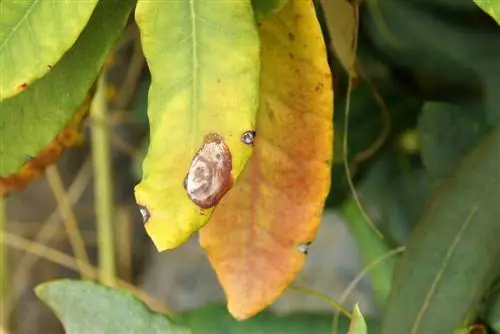
And the branches can also die due to pathogens such as fungi. Here the end bud of the branch is attacked first, which then guides the fungus further into the branch. The affected branches and the leaves on them die. As a countermeasure, it is recommended to remove the affected branches from the rhododendron. Unfortunately, watering with appropriate poisons against this disease is no longer permitted.
Tip:
Do not throw the infected branches into the compost. The fungus can survive there. It is better to dispose of these with household waste.
Powdery mildew
If mildew forms on the leaves and shoots of the rhododendron, their growth is restricted. On a deciduous rhododendron, the covering appears gray-white. In a rhododendron that is green all year round, the affected leaves and branches are covered in yellow spots. Powdery mildew is a fungus that can be treated quite well with pesticides. Recommended treatments include Mushroom-Free Ectivo, Duaxo Universal Mushroom-Free or Netzsulfur WG.
Tip:
Most pesticides are used preventatively. You should therefore water it regularly so that mildew cannot infect your trees in the first place.
General information
How long a pesticide is used usually depends on the success of the treatment. If this occurs quickly, the drug can be discontinued quickly. If the infestation is quite advanced, please be patient and use the product over a longer period of time.
Frequently asked questions
Where is the best location for rhododendrons?
The rhododendron likes it slightly shady. A partially shaded spot that offers sun but also enough shade is ideal.
Can harmful substances and diseases be prevented?
Yes. Always make sure that the pH value of the soil is correct. Fertilize regularly and supply the most important nutrients.
Can diseases cause the entire tree to die?
Very stubborn pests and diseases can do this. Therefore, check your rhododendron regularly and remove affected areas immediately to prevent the disease from spreading.
What you need to know about rhododendron diseases and pests
Preventing diseases
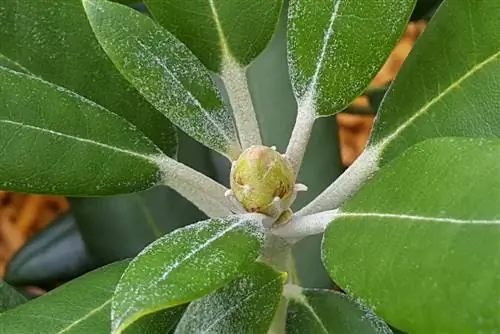
To protect a rhododendron from diseases and pests, the correct soil condition is very important. In general, most plants grow best in soil with a neutral pH, but rhododendrons are an exception. It needs acidic soil with a pH value between 4 and 5.5. If this condition is not present in the garden, the soil can be prepared accordingly by adding peat or using a special rhododendron soil.
Fungal diseases
- Phytophthora cactorum is a fungal infection of rhododendrons.
- The cause of this is fungal spores that spread across the ground and find ideal conditions, especially in humid and warm weather.
- Then first the buds and later the leaves and twigs turn brown, wither and fall off.
- Often only individual shoots are affected, so fungal infestation can be combated by removing the affected branches as early as possible.
- In order to prevent the fungal spores from spreading again, the clippings should under no circumstances be disposed of in the compost.
Fighting pests
- The furrowed black weevil appears from April to May and damages the leaves of the rhododendron by eating parts out of them.
- When fully grown, it is about ten millimeters in size and has a black body with dark brown spots.
- It is usually only active at dusk and at night. These beetles lay their eggs in the soil, where larvae hatch within two to three weeks.
- These larvae cause further damage to the rhododendron by eating the roots.
- A large population of these larvae can even lead to the death of the plant.
Tip:
The larvae of the black weevil can be controlled naturally with nematodes. The affected plant is watered with a mixture of water and the nematodes.
- The rhododendron leafhopper is particularly feared because it transmits a fungus when it lays its eggs in the buds of the rhododendron.
- This fungus causes the flower buds to turn gray or brown, die, but do not fall from the bush.
- Small rods that are about two millimeters long then grow from the buds.
Tip:
Cicadas can be controlled with yellow panels. These are boards made of cardboard or plastic that have adhesive on them and to which the cicadas stick and die.

